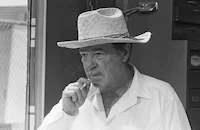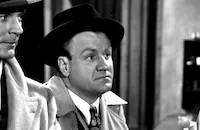Dick Tracy vs. Cueball

Brief Synopsis
Cast & Crew
Gordon M. Douglas
Morgan Conway
Anne Jeffreys
Lyle Latell
Rita Corday Clyde
Ian Keith
Film Details
Technical Specs

Synopsis
After Cueball, a recently released convict, strangles gem buyer Lester Abbott to death in his ocean liner stateroom, he steals Abbott's just purchased diamonds and flees. Police detective Dick Tracy is called to the scene and finds a calling card on Abbott leading him to Abbott's boss, gem dealer Jules Sparkle. At Sparkle's, Tracy orders secretary Mona Clyde to type a company employee list, sure that the theft was an "inside job." While Tracy waits for Mona to finish, he orders his assistant, Pat Patton, to follow another Sparkle employee, lapidary Simon Little, home. While Pat waits outside Little's house, Little meets secretly with Cueball, who demands his $10,000 cut in exchange for the diamonds. Cueball then exits Little's and knocks Pat out from behind before being spotted.
Tracy, meanwhile, follows Mona to Percival Priceless' antique store and sees her slip a note under his door. After Mona leaves, Tracy discovers that Priceless is in the store and confronts him about the note, but Priceless insists that Mona is only a customer. Later, Cueball goes to the Dripping Dagger bar and asks owner Filthy Flora for refuge. Suspecting that Cueball is involved in the much-reported diamond robbery, Flora demands $500 for hiding him, and he agrees. The next day, after Tracy learns that Abbott was strangled with a leather strap, he sends his eccentric colleague, Vitamin Flintheart, to check out Priceless' store. While Vitamin poses as a snobbish antique collector, Mona comes in and confers with Priceless about meeting with Cueball at Flora's. Their suspicions about Priceless confirmed, Tracy and Pat follow him to the Dripping Dagger. Hidden in Flora's office, Cueball demands $20,000 from Priceless, then discovers that Pat and Tracy are in the bar.
Panicked, Cueball strangles Priceless and flees in his car. Later Cueball returns to the Dagger and strangles Flora after she tries to steal his diamonds. Tracy, meanwhile, deduces that the leather strap used to kill Abbott and Priceless came from a certain penitentiary and learns ex-convict Cueball is the killer. Deciding to trap Cueball, Tracy has his own girl friend, Tess Trueheart, pose as a socialite and approach Mona about purchasing diamonds. Mona takes Tracy's bait and tells Cueball that she and Little can only pay him $4,100 for the diamonds because Tess knows they are stolen. Cueball accepts the deal, but then overhears Mona arranging with Tess to buy the jewels from a financially embarrassed man.
Furious at the double-cross, Cueball, posing as a cab driver, takes an unsuspecting Tess to Little's. There Cueball finds a photograph of Tracy in Tess's wallet and is about to strangle her when Tracy and the police burst in and save her. Cueball escapes, however, and in his car, Tracy pursues him to a train yard. During the subsequent chase, Cueball's foot becomes caught in the tracks, and he is killed by an oncoming train. The case solved, Tracy tries to enjoy a birthday dinner with Tess and his foster son Junior, but is called to duty before he can sit down.

Director

Gordon M. Douglas
Cast
Morgan Conway

Anne Jeffreys

Lyle Latell
Rita Corday Clyde

Ian Keith
Dick Wessel

Douglas Walton
Esther Howard

Joseph Crehan

Byron Foulger
Jimmy Crane
Milton Parsons
Skelton Knaggs
Phil Warren
Dorothy Grainger
Jack Cheatham

Ralph Dunn
Raoul Freeman
Robert Bray
William Newell
Max Wagner
Frank Mills
Eddie Borden
Jimmy Clemons
Bill Wallace
Harry Cheshire
Perc Launders
Lee Frederick
Trevor Bardette
Fred Aldrich
Crew
James Anderson
C. Bakaleinikoff
Lucius O. Croxton
Russell A. Cully
Albert S. D'agostino
George E. Diskant
Roy Granville
Robert H. Guhl
Robert E. Kent
Dane Lussier
Philip Martin Jr.
Phil Ohman
Sid Rogell
Herman Schlom
Darrell Silvera
Leslie Urbach
Luci Ward
Shelby Willis

Videos
Movie Clip


Film Details
Technical Specs

Articles
Dick Tracy vs. Cueball
First presented to the public in the Chicago Tribune on October 4, 1931, the square-jawed detective was first played in a quartet of successful Republic serials by Ralph Byrd (Dick Tracy, Dick Tracy Returns, Dick Tracy vs. Crime Inc., Dick Tracy's G-Men) from 1937 to 1939; Byrd then assumed screen duties after Conway and carried the role over to television into the 1950s. From the Depression era through the Atomic Age and beyond, the character continued to resonate with the American public despite -and perhaps because of- its often gritty and stylized violence, much of it lifted from Gould's own personal experiences and research. With its simple good vs. evil dichotomy, the character proved easy to digest for readers and viewers of all ages; as Jon Tuska's The Detective in Hollywood observes, "The primary convention in Dick Tracy is the repeated ultimate success of law and order... Dick Tracy is a champion of ancient values and tradition who exists in a modernly contextualized old gothic wilderness. His story, at least on the levels of myth and tradition, is not wholly different from that of Nathaniel Hawthorne's Young Goodman Brown who goes into the forest and meets the devil."
Running a tight 62 minutes, this second of four RKO Dick Tracy adventures revels in its colorful atmosphere (following the first film, simply titled Dick Tracy) and paves the way for future installments including the most well-known, Dick Tracy Meets Gruesome (1947). The switch from Republic to RKO for these feature renditions ensured higher production values and tighter storytelling, of which Dick Tracy vs. Cueball is a prime example; there's scarcely a second wasted as Tracy hurtles through a rogues' gallery of characters (including viewer favorite Vitamin Flintheart) towards the memorable, strikingly gruesome finale with Cueball squaring off against a fast-moving train.
Dick Tracy vs. Cueball also marks the sole series directorial effort for busy director Gordon Douglas, a former child actor and seasoned "Our Gang" shorts director, who had just completed the bizarre Bela Lugosi comedy, Zombies on Broadway (1945). A reliable craftsman if never a real auteur, he went on to a lengthy career filled with several peaks (1954's Them! and Young at Heart, 1967's In Like Flint) and a few valleys (1955's ill-fated Liberace vehicle Sincerely Yours and 1977's Viva Knievel!), while his thriller expertise already shown here served him well later with a series of Frank Sinatra vehicles including 1968's The Detective and two Tony Rome films (Tony Rome [1967] and Lady in Cement, 1968), 1970's They Call Me MISTER Tibbs! with Sidney Poitier, and even a stop-off in blaxploitation with 1973's Slaughter's Big Rip-Off.
Also carried over from Zombies on Broadway was leading lady Anne Jeffreys, making her second and last appearance as Tracy's long-time girlfriend (and eventual wife), Tess Trueheart. A frequent stage and nightclub performer and singer, she appeared intermittently onscreen as the "good girl" in a string of thrillers and westerns. However, she found her most enduring success as the sprightly ghost Marion Kerby on the popular 1950s TV sitcom adaptation of Topper. Even in her eighties, she continued to return to popular crime-fighting series-- by appearing regularly as David Hasselhoff's mother on Baywatch!.
Producer: Sig Rogell, Herman Schlom
Director: Gordon Douglas
Screenplay: Luci Ward (story), Dane Lussier, Robert E. Kent
Based on the comic strip by Chester Gould Cinematography: George E. Diskant
Film Editing: Philip Martin
Art Direction: Lucius O. Croxton, Albert S. D'Agostino
Music: Phil Ohman
Cast: Morgan Conway (Dick Tracy), Anne Jeffreys (Tess Trueheart), Lyle Latell (Pat Patton), Rita Corday (Mona Clyde), Ian Keith (Vitamin Flintheat), Dick Wessel (Harry 'Cueball' Lake).
BW-62m.
.
by Nathaniel Thompson

Dick Tracy vs. Cueball
Quotes
Trivia
Notes
Dick Tracy vs. Cueball was the second film in RKO's "Dick Tracy" series. The film's opening credits conclude with a special introduction for the character "Cueball." For more information about the series, for Dick Tracy and consult the Series Index. In 1966, the film was re-issued with Dick Tracy Meets Gruesome by Screen Entertainment, Inc.

Miscellaneous Notes
Released in United States Winter December 18, 1946
Released in United States Winter December 18, 1946













